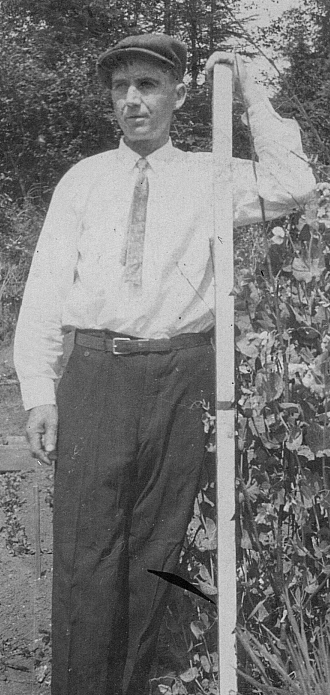In May 1891, Frank’s father died prematurely of a stroke. In 1895, Frank’s mother remarried and eventually moved to The Dalles, Oregon. Blacksmith’s by trade, Frank worked with his two brothers Sherman and Ed in Klickitat County shoeing horses and fixing farm equipment.
On October 7, 1899, Frank married Etta Harris (1877-1941) of Santa Rosa, CA. Nine months later on July 12, 1900, James Lyndon Cooley was born. In 1900, with a family to support, Frank needed a steady paying job. He found it in Betteravia, California—a company town that needed a full-time blacksmith to shoe horses and fix stuff.
Six miles west of Santa Maria in Northern Santa Barbara County, was a sugar mill company town founded on the former Rancho Punta de Laguna. The sugar mill extracted sucrose from sugar beets, a tuber from which thirty percent of today’s sugar is derived. In 1897, the Union Sugar Mill was completed at Betteravia and, in 1899, the Southern Pacific Railway completed its branch from Guadalupe to Betteravia to service the mill. Betteravia supported a population of 350 residents, most of whom were employed by the Union Sugar Company. The community consisted of 65 cottages, a hotel, church, schoolhouse, post office, amusement hall, general store, gasoline station, and a fire department (Renee Besta, 2012).
In January 1913, a daughter, Hazel Helen Cooley, was born. Frank was ready for a new challenge, leaving the Union Sugar Company in Betteravia for the opportunity to work as a blacksmith at The Pullman Shops in Richmond, CA. In addition, Etta wanted to be closer to her mother Martha Jane Lock Harris in Santa Rosa, CA.
In March of 1910 construction had begun on 22 acres of what would become the Richmond Car Repair Shops of The Pullman Company. The facility was built with men, horses and wheelbarrows. All the concrete was mixed by hand. The exterior was faced with 350,000 white sandstone bricks. In September the first large pieces of machinery, a wheel press and giant lathe, arrived from the Denver shops.
The shops opened on Nov. 27, 1910 just as Pullman had begun its massive conversion to all steel cars. Train speed and length had increased dramatically in the last ten years, and the safety steel provided was demanded by the railroads. Richmond was built with complete facilities to work on the wood cars as the steel car conversion would end up lasting until the 1930's (The Pullman Shops.com, 2012).
On September 12, 1917, Frank and his son Lyndon signed up for the WWI draft and listed their occupations as blacksmiths at The Pullman Shops in Richmond, CA.
By 1925, Frank had taken a job as an automobile mechanic and had moved the family back to 630 Madison Street, Santa Rosa, CA. On October 9, 1925 James Franklin Cooley died. He is buried in the Odd Fellows Cemetery, Section D, Lot 5, Santa Rosa Memorial Park, Santa Rosa, CA.
Source: Lenny Andreasen, 2009
Ancestry.com
In May 1891, Frank’s father died prematurely of a stroke. In 1895, Frank’s mother remarried and eventually moved to The Dalles, Oregon. Blacksmith’s by trade, Frank worked with his two brothers Sherman and Ed in Klickitat County shoeing horses and fixing farm equipment.
On October 7, 1899, Frank married Etta Harris (1877-1941) of Santa Rosa, CA. Nine months later on July 12, 1900, James Lyndon Cooley was born. In 1900, with a family to support, Frank needed a steady paying job. He found it in Betteravia, California—a company town that needed a full-time blacksmith to shoe horses and fix stuff.
Six miles west of Santa Maria in Northern Santa Barbara County, was a sugar mill company town founded on the former Rancho Punta de Laguna. The sugar mill extracted sucrose from sugar beets, a tuber from which thirty percent of today’s sugar is derived. In 1897, the Union Sugar Mill was completed at Betteravia and, in 1899, the Southern Pacific Railway completed its branch from Guadalupe to Betteravia to service the mill. Betteravia supported a population of 350 residents, most of whom were employed by the Union Sugar Company. The community consisted of 65 cottages, a hotel, church, schoolhouse, post office, amusement hall, general store, gasoline station, and a fire department (Renee Besta, 2012).
In January 1913, a daughter, Hazel Helen Cooley, was born. Frank was ready for a new challenge, leaving the Union Sugar Company in Betteravia for the opportunity to work as a blacksmith at The Pullman Shops in Richmond, CA. In addition, Etta wanted to be closer to her mother Martha Jane Lock Harris in Santa Rosa, CA.
In March of 1910 construction had begun on 22 acres of what would become the Richmond Car Repair Shops of The Pullman Company. The facility was built with men, horses and wheelbarrows. All the concrete was mixed by hand. The exterior was faced with 350,000 white sandstone bricks. In September the first large pieces of machinery, a wheel press and giant lathe, arrived from the Denver shops.
The shops opened on Nov. 27, 1910 just as Pullman had begun its massive conversion to all steel cars. Train speed and length had increased dramatically in the last ten years, and the safety steel provided was demanded by the railroads. Richmond was built with complete facilities to work on the wood cars as the steel car conversion would end up lasting until the 1930's (The Pullman Shops.com, 2012).
On September 12, 1917, Frank and his son Lyndon signed up for the WWI draft and listed their occupations as blacksmiths at The Pullman Shops in Richmond, CA.
By 1925, Frank had taken a job as an automobile mechanic and had moved the family back to 630 Madison Street, Santa Rosa, CA. On October 9, 1925 James Franklin Cooley died. He is buried in the Odd Fellows Cemetery, Section D, Lot 5, Santa Rosa Memorial Park, Santa Rosa, CA.
Source: Lenny Andreasen, 2009
Ancestry.com
Family Members
Sponsored by Ancestry
Advertisement
Explore more
Sponsored by Ancestry
Advertisement






